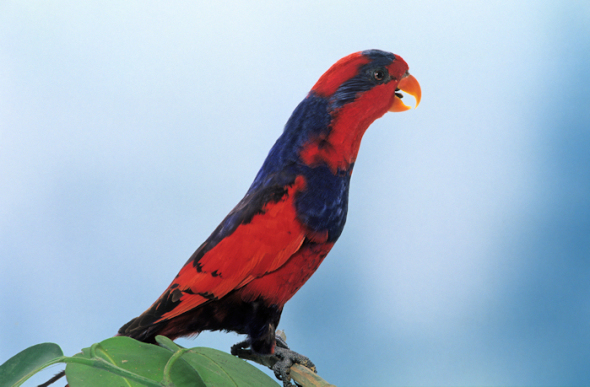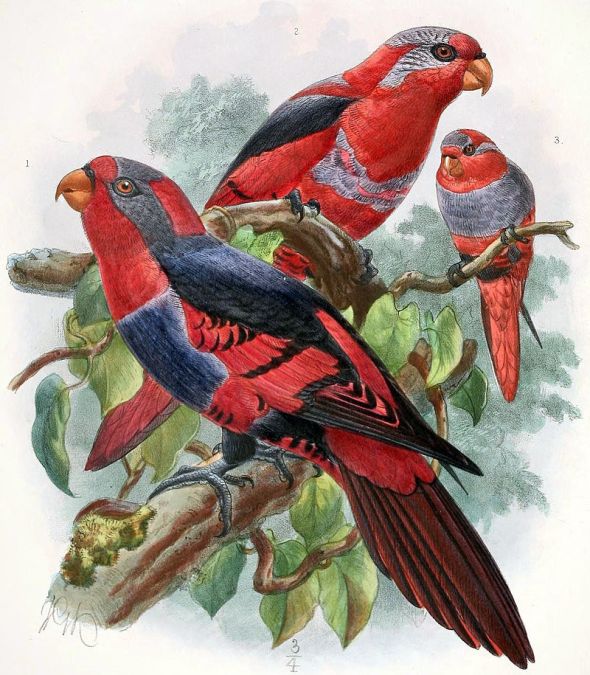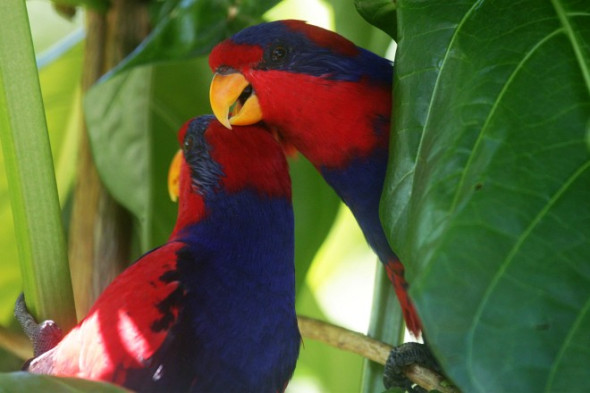Endangered Species Monday: Eos histrio
Endangered Species Monday: Eos histrio
This Monday’s endangered species watch post I speak about an all time favorite bird of mine commonly known as the red and blue Lory. Generically identified back in 1776 as the Eos histrio, the species of bird is unfortunately listed as endangered. (Image: Eos histrio)
Identified by Professor Philipp Ludwig Statius Muller (April 25, 1725 – January 5, 1776) Dr P.L.S Muller was a German zoologist. Statius Muller was born in Esens, and was a professor of natural science at Erlangen. Between 1773 and 1776, he published a German translation of Linnaeus’s Natursystem.
The supplement in 1776 contained the first scientific classification for a number of species, including the dugong, guanaco, potto, tricolored heron, umbrella cockatoo, red-vented cockatoo, and the enigmatic hoatzin. He was also an entomologist.
Endemic to Indonesia populations are decreasing like many birds of its kind now within the country. The red and blue Lory was listed as endangered back in 2012 of which population sizes haven’t really increased since this time-frame. Back in 1999 a rather crude evaluation was undertaken by scientists that estimated the population to be standing at roughly 8,500 to 21,400 birds. This evaluation would then place the number of “mature individuals” at a rather depressing 5,400 to 14,000, hence its qualification for the listing of [endangered].
Red and blue Lory can be mostly found on the Talaud Islands (almost exclusively on Karakelang) off northern Sulawesi, Indonesia although, it was previously known to be abundant. Populations have declined fiercely on Karakelang of which its population sizes as explained stand at around 8,500 to 21,400 birds. The nominate subspecies, known from the Sangihe Islands, is probably now “extinct” however, further scientific evaluations around have still to confirm a sub-species extinction.
Diet will normally consist of fruit and insects of which the red and blue Lory will normally collect said foods in dense forest and woodland. Coconut nectar and cultivated fruits from agricultural land have been documented to be part of the red and blue Lory’s diet too.
Image: Suspected extinct sub-species; Extinct subspecies E. h. histrio and E. h. challengeri.
Red and blue Lory’s are recorded at high densities in primary rain-forests rather than low densities. The species will at times tolerate some secondary rain-forest however, it must be noted high density primary rain-forest remains the - birds preferred habitat. E. histrio are not known to commonly build nests like some species of forest dwelling bird do within the family of Psittaculidae. Normally the species can be witnessed nesting within holes in trees which at times is rather comical if you’ve ever seen the species in the wild as I have.
Image: Red and blue Lory - mates forever.
Breeding time is quite typical from May through to June however, some reports have suggested that the species may nest through to June and/or January. Red and blue Lory’s are not known to be a migratory species however will at times locally migrate to local islands out of Indonesia to roost. These movements though must not be considered or documented as migratory.
Listed on appendix I of the Convention on International Trade of Endangered Species wild flora and fauna (Cites) the species faces many threats highlighted below for your attention;
Threats
Trade represents a significant and on-going threat to the species. It was widely trapped as early as the 19th century. In 1999, research suggested that as many as 1,000-2,000 birds were being taken from Karakelang each year, 80% (illegally) to the Philippines. This is compounded by the extensive loss of forest, perhaps the main factor underlying its disappearance from Sangihe. The reasons behind habitat loss are small-holder agricultural encroachment into primary forest and (illegal) commercial logging. Furthermore, in 2003 there were plans to develop a commercial banana plantation on Karakelang. The use of insecticides and the transmission of disease via escaped cage-birds to wild populations, have been identified as a further potential hazards.
While conservation actions are underway the species continues to decline at astronomical rates. I doubt that the species will still be around by the time I hang up my gloves and retire. Extinction is sadly looming, occurring all over Asia at alarming rates, its highly unlikely the red and blue Lory will pull through.
Thank you for reading.
Dr Jose C. Depre
Environmental and Botanical Scientist.






Thank you for your reply, should it merit a response we will respond in due course. This site is owned by International Animal Rescue Foundation and moderation is used.